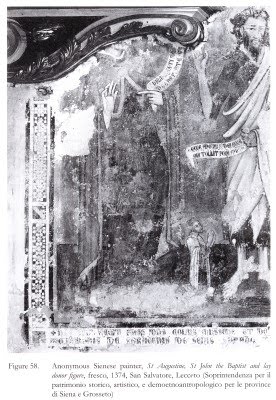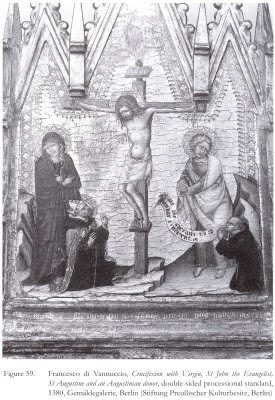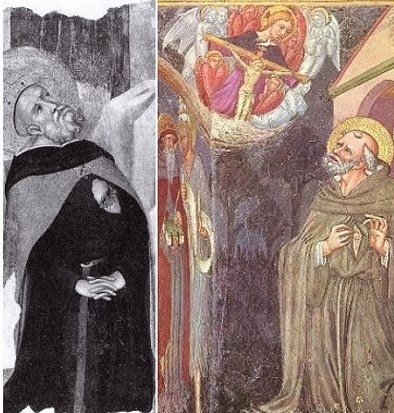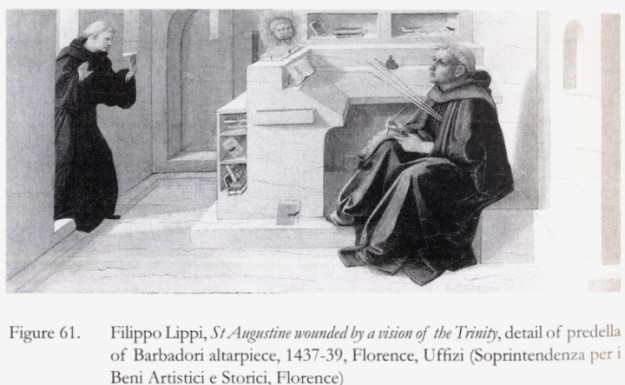Marco, thanks so much for the translation. What a terrible God was the God of the Old Testament.
Pen
Re: Absalom and the Sola Busca Three of Swords
32I have finally had a chance to put together what I submit as a proper analysis of the SB 3 of Swords, expanding on my earlier very short (for me) post. I have revised my exposition of this card on the thread "Deciphering the Sola-Busca Pips" accordingly. Go there to see how I think this analysis fits the Neopythagorean perspective on theSB 3s.
Here we have Jesus as he is killed in the Crucifixion, and also something in the heart of the believer as a result of contemplating that wounding and slow death.
I think we need to see the image in the context in which three arrows stabbing the heart appeared at that time in Italy. The Augustinians were developing imagery around their chosen saint, Augustine, meant to be comparable to the stigmatization of St. Francis. I will show six early examples, starting in the 1360's and 1370's, through the 1420's. I get all of them, and the analysis, from Donal Cooper's "St. Augustine's Ecstasy before the Trinity in the Art of the Hermits, c. 1360-c. 1440," in Art and the Augustinian Order in Early Renaissance Italy.
The first image is c. 1374 Siena, anonymous painter (Cooper p. 191). It is the bottom of a crucifixion scene, showing Augustine on the left and John the Baptist in the middle. Augustine is pointing to his heart, and there are words at the bottom.

The next image is c. 1380, the relevant detail of Francesco di Vannuccio, Crucifixion with Virgin, St. John the Evangelist, St. Augustine and an Augustinian donor, Siena 1380 (Cooper, p. 193). St. Augustine is looking up, with blood and water spurting from Jesus's side, and something like rays extending down to the saint. At the crucifixion, Jesus was pierced by nails and stabbed by the spear of Longinus. But we can't see what is happening to Augustine. An analogy to the stigmatization of St. Francis is evident.

In this fresco, a donor stands to the right of the cross, from whom a banner extends toward the cross, reading ""Vulnerasti domine cor meum caritate tua" (Cooper p. 197), i.e. "You have wounded my heart with your charity." Very similar words appear at the bottom of the previous fresco, "Vulnerasti cor meum de charitate tua." The wording is not found as such in Augustine's writings; the closest is Confessions IX: "You had pierced our hearts with the arrows of your love [charity], and we carried your words with us as though they were staked to our living bodies" ("Saggitaveras tu cor nostrum caritate tua et gestabamus verba tua transfixa visceribus," Cooper p. 197). The inscriptions merely substitute "meum" for "nostrum" and "vulnerasti," echoing the famous "vulnerasti cor meum" of Song of Songs 4:9, for "sagittaveras."

Above are two more images. The one on the left is a detail from a painted panel crucifixion by Nicoletto Seitecolo,, Padua 1360s (Cooper p. 190). I have just shown the saint. Above him (not seen here) is Christ on the cross. Cooper says (p. 190)

Finally I get to the image that most closely corresponds to the SB 3 of Swords (Cooper p. 194).

Cooper observes (p. 195):
It is this wreath, I think, that makes the subject Christ and the Christian believer rather than, for example, the otherwise similar image of Absalom, the rebellious son whom David sorrowfully has his men put to death, as Pen suggested. It could, as an isolated image, represent David's victory, and so the victory of his god, but Absalom's death is not noble and inspiring like Jesus's; wreaths were associated with heroes. It also doesn't fit the overall theme of the 3s, which I see as primarily about the Trinity (which in the 15th century was considered a Pythagorean doctrine, e.g. by Cusa (see viewtopic.php?f=12&t=530&p=9379&hilit=Cusa#p9379), and the Son in particular.
That the Lippo Lippi painting was in Florence is one reason out of several for thinking that the designer of the deck's program was a Florentine, or at least someone very familiar with Florence. I have given the evidence elsewhere in the Forum, but here is a summary. I have in mind especially Poliziano, because (a) notes in his handwriting are reportedly in the Laurentian Library's copy of the Theologumena Arithmeticae, (b) he was an expert in Roman history, as reflected in the SB trumps, (c) he designed pageants and other playful entertainments, with Lorenzo, (d) he visited Venice (and, I would assume Ferrara) in the late 1480s in company with Pico della Mirandola; and (e) the deck reflects his homoerotic tastes. He was denied access to the Bessarion collection but must have had access to the relevant manuscript by other means, because of the one now in the Laurentian. In 1494 he died by arsenic poisoning along with Pico.
Here we have Jesus as he is killed in the Crucifixion, and also something in the heart of the believer as a result of contemplating that wounding and slow death.
I think we need to see the image in the context in which three arrows stabbing the heart appeared at that time in Italy. The Augustinians were developing imagery around their chosen saint, Augustine, meant to be comparable to the stigmatization of St. Francis. I will show six early examples, starting in the 1360's and 1370's, through the 1420's. I get all of them, and the analysis, from Donal Cooper's "St. Augustine's Ecstasy before the Trinity in the Art of the Hermits, c. 1360-c. 1440," in Art and the Augustinian Order in Early Renaissance Italy.
The first image is c. 1374 Siena, anonymous painter (Cooper p. 191). It is the bottom of a crucifixion scene, showing Augustine on the left and John the Baptist in the middle. Augustine is pointing to his heart, and there are words at the bottom.

The next image is c. 1380, the relevant detail of Francesco di Vannuccio, Crucifixion with Virgin, St. John the Evangelist, St. Augustine and an Augustinian donor, Siena 1380 (Cooper, p. 193). St. Augustine is looking up, with blood and water spurting from Jesus's side, and something like rays extending down to the saint. At the crucifixion, Jesus was pierced by nails and stabbed by the spear of Longinus. But we can't see what is happening to Augustine. An analogy to the stigmatization of St. Francis is evident.

In this fresco, a donor stands to the right of the cross, from whom a banner extends toward the cross, reading ""Vulnerasti domine cor meum caritate tua" (Cooper p. 197), i.e. "You have wounded my heart with your charity." Very similar words appear at the bottom of the previous fresco, "Vulnerasti cor meum de charitate tua." The wording is not found as such in Augustine's writings; the closest is Confessions IX: "You had pierced our hearts with the arrows of your love [charity], and we carried your words with us as though they were staked to our living bodies" ("Saggitaveras tu cor nostrum caritate tua et gestabamus verba tua transfixa visceribus," Cooper p. 197). The inscriptions merely substitute "meum" for "nostrum" and "vulnerasti," echoing the famous "vulnerasti cor meum" of Song of Songs 4:9, for "sagittaveras."

Above are two more images. The one on the left is a detail from a painted panel crucifixion by Nicoletto Seitecolo,, Padua 1360s (Cooper p. 190). I have just shown the saint. Above him (not seen here) is Christ on the cross. Cooper says (p. 190)
The image on the right is from Otaviano Nelli, Ecstasy of Augustine before the Trinity, c. 1420-1430, in Gubbio, Umbria (Cooper 188, but here from http://nibiryukov.narod.ru/nb_pinacotec ... escoes.htm. Here we have both the crucifixion and the exposure of the wounded heart. We have the other members of the Trinity as well. The Father is holding the cross; I am not sure exactly where in that mass of wings the Holy Spirit is. but I think I see a very small white dove just above the cross and below the Father's chin. Cooper comments:...a slit in his habit opens to receive a set of rays emanating from a light source above his head (figs. 56-57). Here the analogy with Francis stigmatisation is more emphatic, for the rays strike an open and bleeding wound in Augustine's chest.
The same imagery, showing the Trinity more clearly but without the exposed heart, appears in a painting by an anonymous Florentine painting, second half of the 14th century (Cooper p. 194).Nelli's fresco depicts Augustine kneeling in a chapel doorway, his gaze fixed upon an apparition of the Trinity, figured as the Throne of Mercy and enveloped by angels. ...The saint delicately opens a slit in his habit to reveal his heart, on which Nelli has traced a miniature, ghostly reflection of the Trinity. The Gubbio fresco takes its iconographic cue from the established visual repertoire of Francis' stigmatization. (Cooper p. 186)

Finally I get to the image that most closely corresponds to the SB 3 of Swords (Cooper p. 194).

Cooper observes (p. 195):
It is this image that the designer of our card has used, it seems to me. Looking at the crucifixion, the believer receives the Trinity into his heart, mirroring the piercing of Jesus on the cross in the way that St. Francis' stigimatisation did but in one place rather than the usual five. In that way, the experience of Christ's suffering turns into a victory for the immortal soul, and for Jesus's mission. This victory is symbolized by the wreath hanging below the cross.Rather unusually, Lippi rendered the Trinity as three conjoined cherub heads, and he placed the scene in Augustine's study, with the saint wearing the Hermits' black habit but no vestments or mitre. Looking up from his scroll, Augustine is struck in the chest--and, one presumes, his heart--by three golden arrrows.
It is this wreath, I think, that makes the subject Christ and the Christian believer rather than, for example, the otherwise similar image of Absalom, the rebellious son whom David sorrowfully has his men put to death, as Pen suggested. It could, as an isolated image, represent David's victory, and so the victory of his god, but Absalom's death is not noble and inspiring like Jesus's; wreaths were associated with heroes. It also doesn't fit the overall theme of the 3s, which I see as primarily about the Trinity (which in the 15th century was considered a Pythagorean doctrine, e.g. by Cusa (see viewtopic.php?f=12&t=530&p=9379&hilit=Cusa#p9379), and the Son in particular.
That the Lippo Lippi painting was in Florence is one reason out of several for thinking that the designer of the deck's program was a Florentine, or at least someone very familiar with Florence. I have given the evidence elsewhere in the Forum, but here is a summary. I have in mind especially Poliziano, because (a) notes in his handwriting are reportedly in the Laurentian Library's copy of the Theologumena Arithmeticae, (b) he was an expert in Roman history, as reflected in the SB trumps, (c) he designed pageants and other playful entertainments, with Lorenzo, (d) he visited Venice (and, I would assume Ferrara) in the late 1480s in company with Pico della Mirandola; and (e) the deck reflects his homoerotic tastes. He was denied access to the Bessarion collection but must have had access to the relevant manuscript by other means, because of the one now in the Laurentian. In 1494 he died by arsenic poisoning along with Pico.
Last edited by mikeh on 18 Feb 2011, 03:26, edited 1 time in total.
Re: Absalom and the Sola Busca Three of Swords
33Very convincing, Mike. Compelling reasons why three wounds to the heart can be seen as victory rather than defeat - there can't be many situations in which this is remotely possible. The difference between swords and arrows in the card and images raises the only doubt in my mind, in spite of St. Sebastian.
Pen
Pen
He's not the Messiah, he's a very naughty boy...
Re: Absalom and the Sola Busca Three of Swords
34Nicely put, Pen. Well, swords and arrows are similar. Also, if the artist had used arrows, people might think of Cupid's arrows, which are also aimed at the heart; so they might get the wrong idea, that the love was cupiditas rather than caritas.
